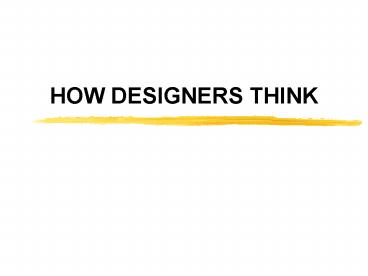HOW DESIGNERS THINK - PowerPoint PPT Presentation
1 / 42
Title:
HOW DESIGNERS THINK
Description:
Suwa-Gero-Purcell coding scheme. Content-oriented analysis ... Suwa-Gero-Purcell Coding Scheme. D-action: draw. M-action: moving without drawing ... – PowerPoint PPT presentation
Number of Views:151
Avg rating:3.0/5.0
Title: HOW DESIGNERS THINK
1
HOW DESIGNERS THINK
2
Empirically-Based Studies
- surveys
- direct observation (in situ)
- direct observation (input-output models)
- protocol analysis
3
Protocol Analysis data from verbal utterances
- Recording method
- Concurrent method Record actions and think-aloud
concurrently - Retrospective method Record actions and after
session completed record verbalisation - Analysis method
- Process-oriented analysis
- Content-oriented analysis
4
Protocol Analysis
- Video and audio taping
- Transcription
- Code development
- Coding
- Analysis
5
Coding Method
6
Coding Scheme for Design Processes
7
(No Transcript)
8
Process Information About Designing
- How much time is spent doing what?
- What is the distribution of the time of
activities over a design session? - What differences are there between experts and
novices? - Experiment
- Conceptual design tasks
- Novice graduate designers
- Designers with more than 5 years experience
- Think aloud method
- Process-oriented analysis
- Present typical results only
9
Time spent drawing for a novice circuit designer
10
(No Transcript)
11
Total time spent reasoning about Function and
Behaviorvs Total time spent reasoning about
Structure Novice
Function Behaviour
Structure
100
75
of Total Time Spent in Category
50
25
0
0
25
50
75
100
Time As a Percentage of the Total Time Taken
12
Total time spent reasoning about Function and
Behaviorvs Total time spent reasoning about
Structure Expert
13
Asimows Model of Designing
- analysis
- synthesis
- evaluation
14
Empirical Testing of Asimows Model
Evaluation -gt Reformulation
Evaluation -gt Synthesis
15
Revised Asimow Model
16
Distribution of Activities - Expert
50
45
40
35
30
Percentage of Total Time
25
20
15
10
5
0
Pa
Ev
Ju
Ca
An
Ps
Cl
Re
Dd
Co
Pp
La
Lb
Ka
Kd
Ds
Activity Code
17
Distribution of Activities - Novice
18
Spectral Distribution of Events
19
Fixation
- Fixation exposure to an existing design has
effect on current designing - pictorial representation of a possible design
- pictured design uses principles that are part of
the knowledge base of the discipline
20
Experiment
- Subjects
- Final year mechanical engineering students
- Final year industrial design students
Design Task
- Device for assisting the elderly in getting into
and out of a bath
21
Experimental Design
- Two groups from each discipline
- One group given the verbal instructions
- One group given the verbal instructions and the
picture of the example design
22
(No Transcript)
23
(No Transcript)
24
(No Transcript)
25
(No Transcript)
26
(No Transcript)
27
Significant Superficial Features
- Fixed to base plate
- Rigid boom
- Orientation to bath as in example
- Tiles on side of bath as in example
- Fixed to bolted base plate
- Moulded seat with back
- Perforated seat
28
(No Transcript)
29
Discussion
- Fixation occurred differently with mechanical
engineers and industrial designers - Fixation occurred with analogical and superficial
features - Appropriate and inappropriate fixation
- Multiple examples and fixation
- Multiple examples and innovation
30
EXPERTS VS NOVICES
- Case study of an expert and a novice architect
- Expert appears to be 2.8 times as productive as
novice - What might be the causes?
31
Protocol Studies of Expert and Novice Designer
- Same design task
- Retrospective protocol
- Suwa-Gero-Purcell coding scheme
- Content-oriented analysis
32
Sketches by Expert
33
Sketches by Novice
34
Suwa-Gero-Purcell Coding Scheme
- D-action draw
- M-action moving without drawing
- L-action look at existing depictions
- P-action perceive visual/spatial features of
existing depictions - F-action attach meanings, concepts or functional
issues to existing depictions - G-action set-up of goals
35
Primary Action Codes
36
Secondary Actions
37
Primary Concurrent Actions Correlated with
Depicting Drawings
38
Secondary Concurrent Actions Correlated with
Depicting Drawings
39
Structures of Concurrent Actions Correlated with
Depicting Drawings
40
Structures of Concurrent Actions Correlated with
Depicting Drawings
41
Conclusions
- Differences between expert and novice
- Productivity
- Rate of cognitive activity
- Structure of concurrent actions
- Strategic knowledge
42
Strategic Knowledge
- Expert chunks knowledge into 7 /- 2 concurrent
actions (Millers magic number for human short
term memory capacity) - Novice chunks knowledge into up to 15 concurrent
actions this fails Millers magic number test - Strategic knowledge may be thought of as
successful chunks that have been developed
through interactions with the task































